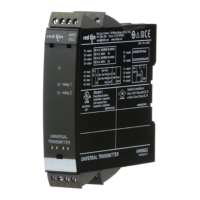
Do you have a question about the red lion IAMS0002 and is the answer not in the manual?
| Product Type | Media Converter |
|---|---|
| Model | IAMS0002 |
| Manufacturer | Red Lion |
| Fiber Optic Ports | 1 |
| Copper Ports | 1 |
| Fiber Connector | SC |
| Interface | 10/100Base-TX to 100Base-FX |
| Operating Temperature | -10°C to 60°C |
Key safety guidelines and general warnings for device operation.
Warnings specific to electrical hazards during installation and operation.
Explanation of symbols and their meanings in the manual.
Detailed safety guidelines for device operation and installation.
Guidelines for mounting the device and recommended operating conditions.
Specific requirements for UL certified installation.
Steps for calibrating and adjusting the device's parameters.
Guidelines for normal use and cleaning procedures.
Step-by-step instructions for safely dismantling the device.
Troubleshooting when the front LED is red or display shows AO.ER.
Detailed description of the device's advanced functionalities.
Various use cases and applications of the device.
Key technical characteristics and operational features.
Overview of the programmer interface functionality and operation.
Instructions for attaching and detaching the PGMMOD module.
Diagrams and descriptions of various input signal types.
Diagrams and descriptions of various output signal types.
Wiring details for the power supply connections.
Operating temperature, humidity, and protection rating.
Dimensions, weights, and physical characteristics.
General electrical and communication specifications.
General accuracy and temperature coefficient values.
Accuracy and temperature coefficients for various input types.
Specifics for RTD, linear resistance, and potentiometer inputs.
Details for Thermocouple input types and their ranges.
Specifications for current and voltage input signals.
Specifications for current and voltage output signals.
Functions and parameters for relay outputs.
Hazardous location approval and observed standards.
How errors and out-of-range signals are displayed.
Specific limits for sensor error detection.
Table of hardware errors, readouts, and causes.
Diagrams for power supply wiring.
Diagrams for various input signal wiring.
Diagrams for output signal and relay wiring.
Schematic showing internal components and signal flow.
How to use function keys for configuration.
Procedures for quick setpoint changes and relay testing.
How to set and use password protection.
Displaying signal and error information using the PGMMOD00.
Indicating signals and errors using LEDs.
Overview of available relay function settings.
How the latch function holds relay states until manual deactivation.
Using window and setpoint modes with the latch function.
How to manually deactivate the latch function.
Adjusting display brightness, contrast, and TAG number.
Procedures for process calibration and signal simulation.
Managing passwords and selecting display languages.
The unit's automatic internal circuit diagnosis.
List of potential errors displayed on the PGMMOD00.
Choosing process units for display.
Enabling SIL mode via loop surveillance.
Saving and transferring device configurations.
Initial settings and input type routing.
Routing for output and relay function settings.
Navigation path for advanced settings like calibration and simulation.
Routing for manual deactivation of latch functions.
Explanations for text displayed in line 3 of the device.
Options for password setup and simulation mode.
Process calibration and sensor type selection.
Enabling and managing the relay latch function.
Visualizing latch function with setpoint and delays.
Visualizing latch function with window and delays.
Visualizing relay action for setpoint (increasing/decreasing).
Visualizing relay action for window (increasing/decreasing).
List of available models and their corresponding part numbers.